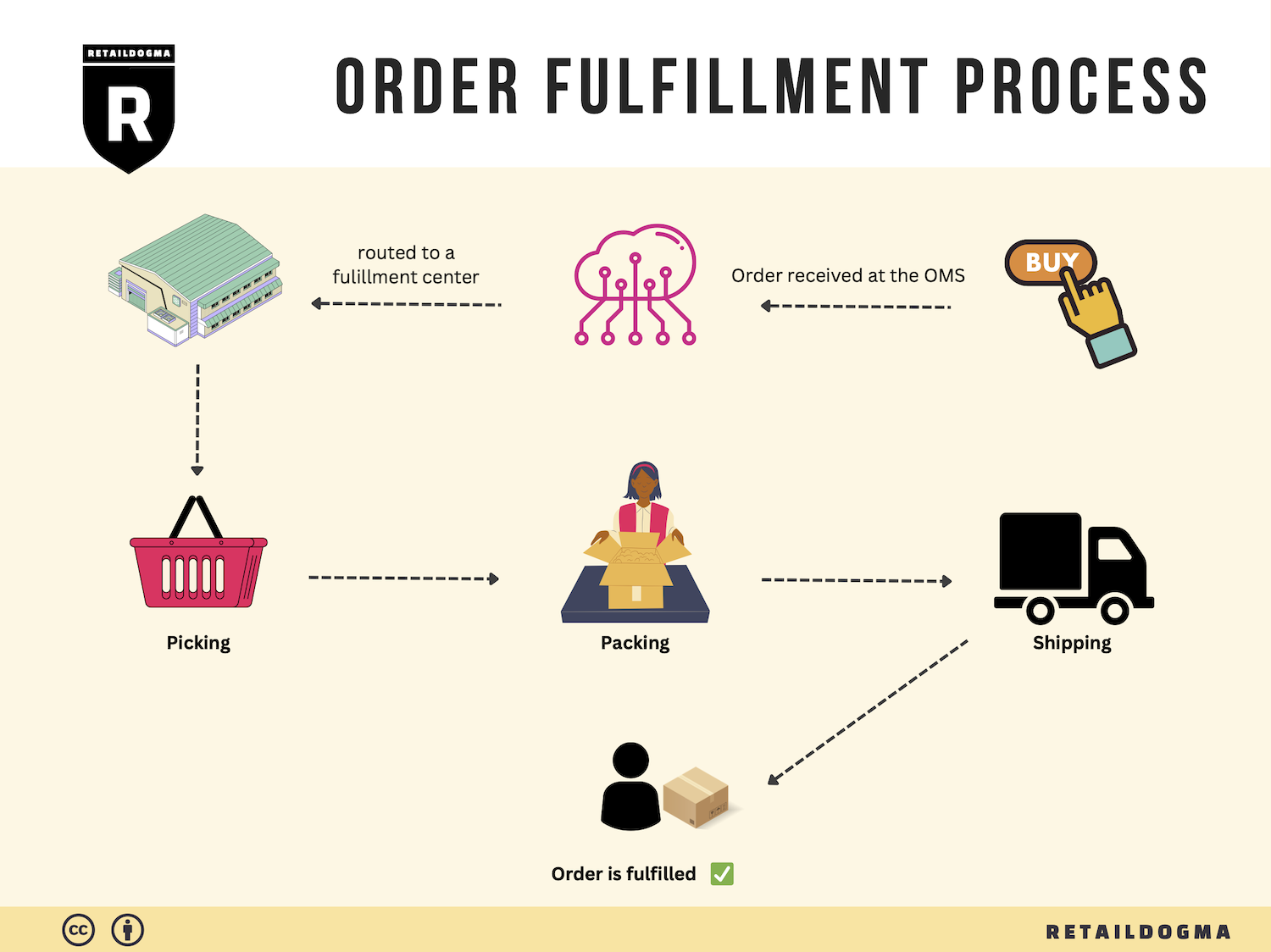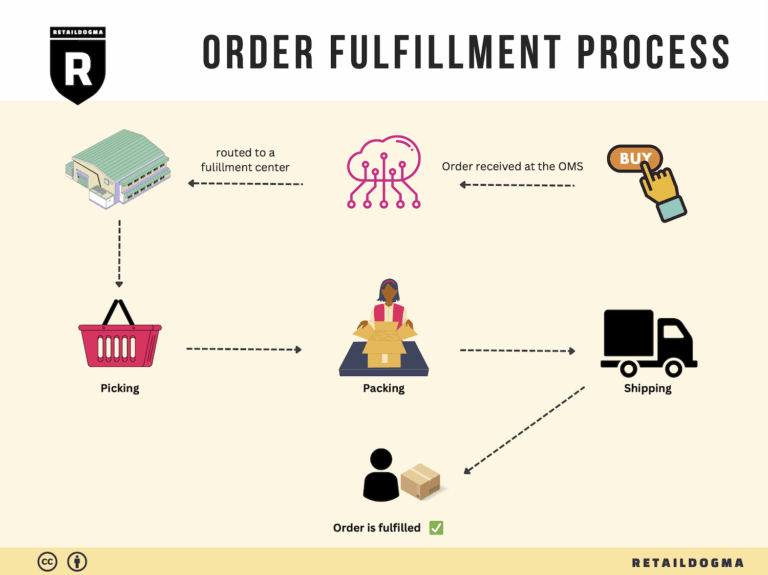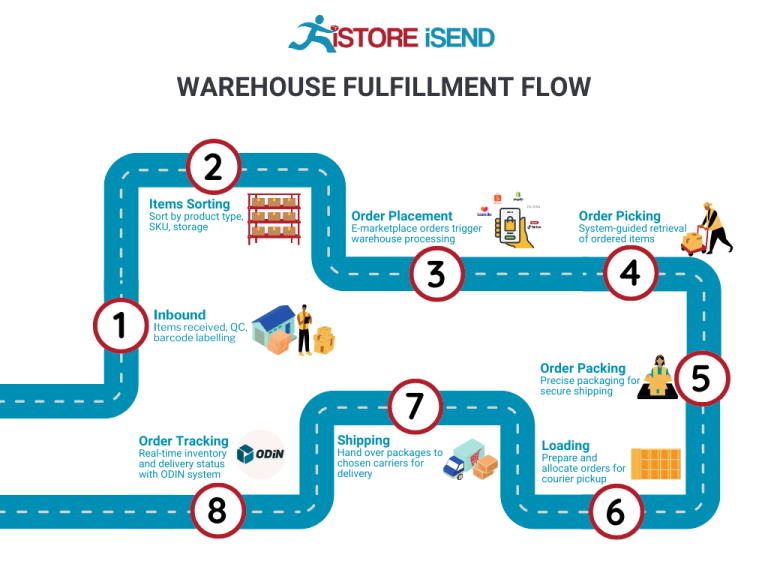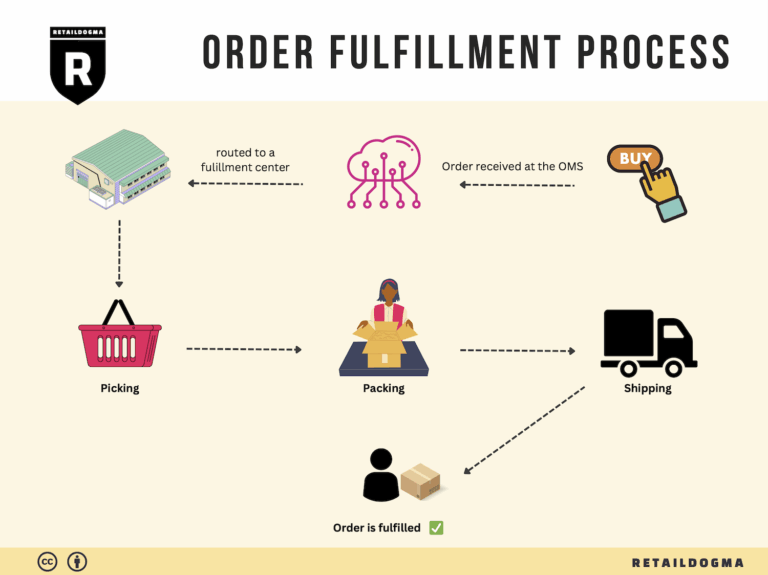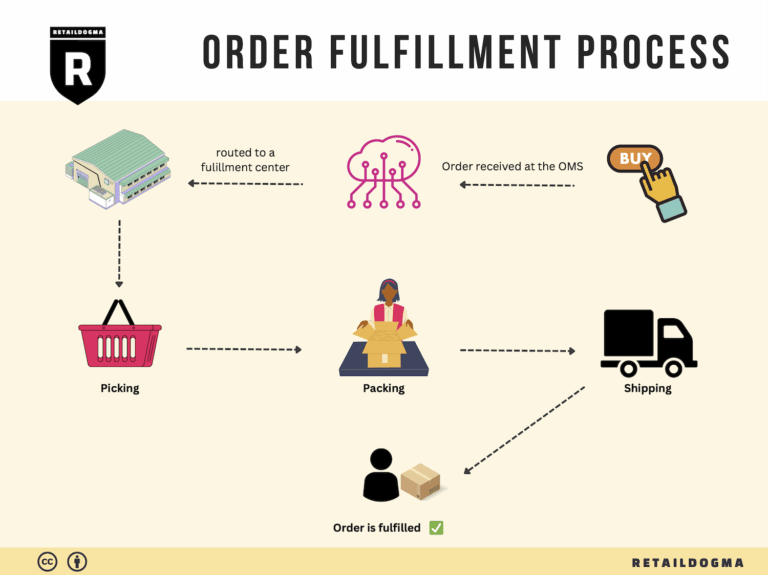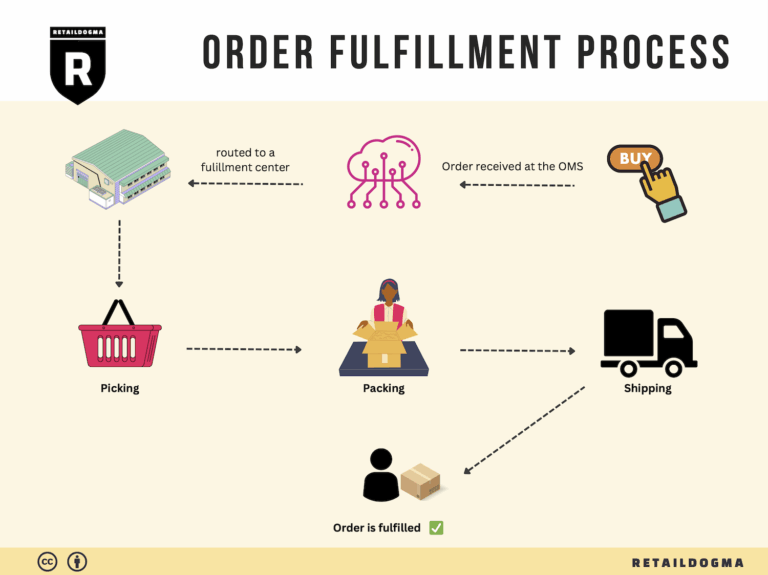How Order Fulfillment Works: A Step-by-Step Guide for Businesses
What is E-commerce Fulfillment? An Introduction for Growing Businesses
Understanding the E-commerce Fulfillment Landscape
As an e-commerce business owner, you might find yourself increasingly overwhelmed with the day-to-day challenges of packing and shipping orders. Scaling your online store often means juggling a myriad of tasks—inventory management, order processing, and logistics—while striving to maintain excellent customer service. This is where e-commerce fulfillment comes into play, serving as a crucial backbone for your operations.
At its core, fulfillment is the process of getting a product from your inventory to your customer’s doorstep. It encompasses everything from receiving orders and managing inventory to packing products and shipping them out. For growing businesses, mastering this process can mean the difference between success and stagnation. A streamlined fulfillment operation not only enhances customer satisfaction but also allows you to focus on scaling your business rather than getting bogged down in logistics.
In this guide, we will explore various facets of e-commerce fulfillment tailored for businesses looking to scale. We’ll cover different fulfillment models such as Third-Party Logistics (3PL) and Fulfillment by Amazon (FBA), helping you understand their unique advantages and how they can fit into your operational strategy.
Additionally, we will delve into core fulfillment services, including inventory management, order processing, and shipping solutions. Understanding these services is essential for making informed decisions about which fulfillment partner to choose.
Choosing the right fulfillment partner can be daunting. We will provide practical tips on what to look for, such as technology integration, scalability options, and customer service capabilities. Furthermore, we will discuss pricing structures to help you evaluate costs effectively and ensure that your chosen solution aligns with your budget and business goals.
Ultimately, this guide aims to empower you to make smart, informed decisions about your logistics operations. By understanding the nuances of e-commerce fulfillment, you can streamline your processes, improve customer satisfaction, and position your business for sustainable growth. Whether you are just starting out or looking to optimize your existing operations, the insights provided here will serve as a valuable resource on your journey to success in the e-commerce landscape.
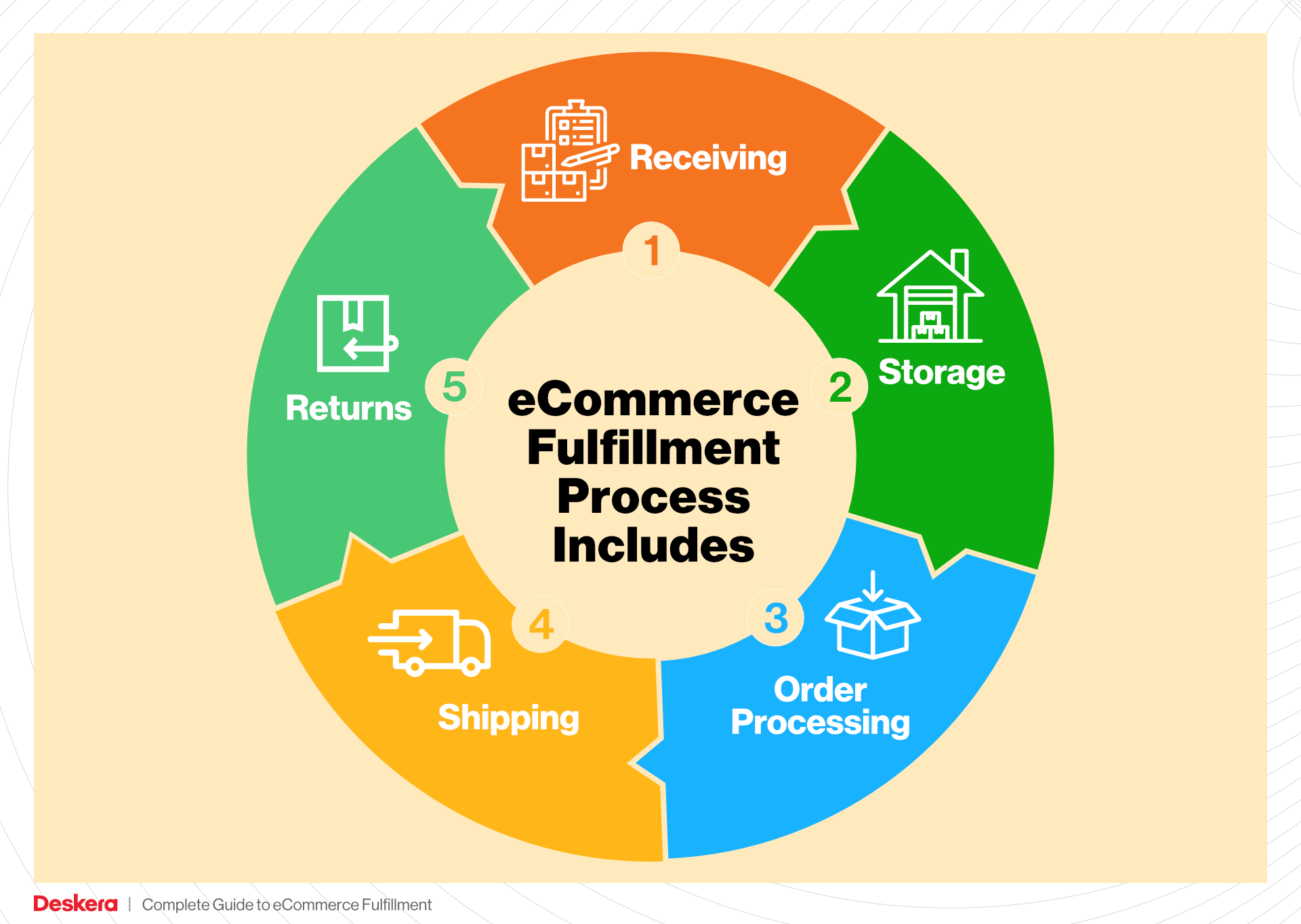
What You’ll Learn In This Guide
- What is E-commerce Fulfillment? An Introduction for Growing Businesses
- The Order Fulfillment Process: From ‘Buy’ Button to Customer’s Door
- Comparing Fulfillment Models: In-House vs. 3PL vs. Dropshipping
- A Deep Dive into Amazon FBA: Pros, Cons, and Who It’s For
- Core Services Offered by Fulfillment Centers
- How to Choose a Fulfillment Partner: A 6-Point Checklist
- Understanding Fulfillment Pricing: A Breakdown of Common Fees
- Frequently Asked Questions (FAQs) about Fulfillment
- Conclusion: Is Outsourcing Fulfillment the Right Move for Your Business?
- Important Disclaimer
The Order Fulfillment Process: From ‘Buy’ Button to Customer’s Door
1. Receiving Inventory
The order fulfillment process begins with receiving inventory. This step involves the intake of goods from suppliers or manufacturers into the fulfillment center. Upon arrival, each shipment is inspected for quality and quantity against the purchase order. Key documents such as packing slips and invoices are verified to ensure that everything matches.
Importance: Effective inventory receiving is crucial as it sets the foundation for the entire fulfillment process. Accurate receiving minimizes discrepancies, reduces errors in inventory levels, and ensures that the right products are available for order fulfillment.
Key Term: SKU (Stock Keeping Unit) – A unique identifier for each product that helps track inventory levels and manage stock efficiently.
2. Warehouse Storage
Once inventory is received and verified, it is stored in the fulfillment center. This step involves organizing products in designated storage locations, which can include shelves, bins, or pallets. Modern fulfillment centers often utilize advanced Warehouse Management Systems (WMS) to optimize storage space and streamline inventory tracking.
Importance: Proper warehouse storage is essential for maximizing space and ensuring quick access to products. An organized storage system facilitates efficient order picking, reduces search times, and enhances overall operational efficiency.
Key Term: Bin Location – A specific area within the warehouse where a product is stored, aiding in quick retrieval during the picking process.
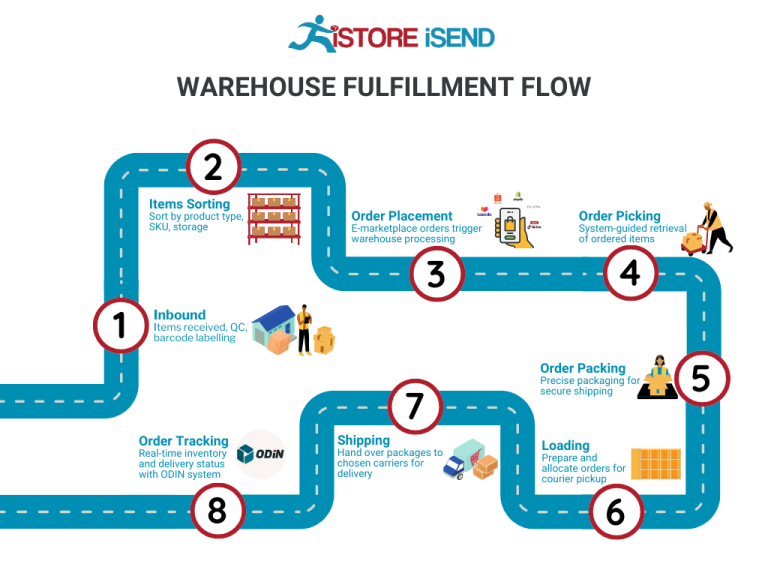
3. Order Picking
Order picking is the process of retrieving products from their storage locations to fulfill customer orders. Workers or automated systems use pick lists, which detail the items and quantities required for each order. This step can involve various methods, including batch picking, zone picking, or wave picking, depending on the fulfillment center’s operational needs.
Importance: Efficient order picking directly impacts customer satisfaction and fulfillment speed. The quicker and more accurately orders are picked, the faster they can be processed and delivered to customers. Errors during this step can lead to incorrect shipments, resulting in increased returns and customer dissatisfaction.
Key Term: Pick List – A document or digital tool that outlines the items needed for an order, guiding pickers to the correct locations in the warehouse.
4. Order Packing
After items are picked, they proceed to the packing stage. Here, products are carefully packaged to ensure they arrive at the customer’s location in perfect condition. This step may include selecting appropriate packaging materials, adding packing slips, and labeling the packages for shipment. Advanced fulfillment centers may also implement automated packing solutions to increase efficiency.
Importance: Effective order packing is vital to prevent damage during transit and to enhance the unboxing experience for customers. Well-packaged orders not only reduce the likelihood of returns but also contribute to a positive brand image.
Key Term: Packing Slip – A document included in the package that lists the contents of the order, providing transparency and helping customers verify their purchases.
5. Shipping & Delivery
The final step in the order fulfillment process is shipping and delivery. Once orders are packed, they are handed over to shipping carriers for delivery to the customer’s address. This step involves selecting the most efficient shipping method, based on factors such as delivery speed, cost, and destination. Many fulfillment centers utilize software to track shipments and provide real-time updates to customers.
Importance: Timely and accurate shipping is critical for maintaining customer satisfaction and loyalty. Efficient shipping processes can differentiate a business in the competitive e-commerce landscape, leading to repeat purchases and positive reviews.
Key Term: Last-Mile Delivery – The final step of the delivery process, where the product is transported from the fulfillment center to the customer’s doorstep, often considered the most critical part of the logistics chain.
By understanding and optimizing each of these five steps in the order fulfillment process, e-commerce business owners can improve operational efficiency, enhance customer satisfaction, and ultimately drive growth in their logistics operations.
Comparing Fulfillment Models: In-House vs. 3PL vs. Dropshipping
Fulfillment Model Comparison
| Model | Who Handles Inventory | Best For (Business Stage) | Key Advantage | Key Disadvantage |
|---|---|---|---|---|
| In-House Fulfillment | The business itself | Established businesses | Complete control over inventory and processes | High overhead costs and resource demands |
| Third-Party Logistics (3PL) | 3PL provider | Growing businesses | Scalability and reduced operational burden | Less control over inventory and processes |
| Dropshipping | Supplier or manufacturer | Startups and small businesses | Low startup costs and minimal risk | Lower profit margins and reliance on suppliers |
In-House Fulfillment
In-house fulfillment involves managing the entire supply chain process within the business. This model is ideal for established businesses that have the resources and infrastructure to handle their own warehousing, inventory management, picking, packing, and shipping. One of the main advantages of in-house fulfillment is the complete control it offers over inventory and logistics processes. Businesses can implement their own systems, customize operations to meet specific needs, and directly oversee the quality of service and customer experience. However, this model also comes with significant disadvantages, primarily high overhead costs associated with maintaining a warehouse, hiring staff, and investing in technology. Additionally, it requires substantial time and resource commitment, which can divert focus from core business activities, especially for companies looking to scale.
Third-Party Logistics (3PL)
Third-party logistics (3PL) providers manage logistics operations on behalf of businesses. This model is particularly beneficial for growing businesses that need to scale their operations without the burden of managing fulfillment in-house. 3PLs offer various services, including warehousing, inventory management, order fulfillment, and shipping, allowing businesses to focus on their core functions such as marketing and product development. A key advantage of utilizing a 3PL is the scalability it provides; businesses can easily adjust their logistics operations based on fluctuating demand without incurring the fixed costs associated with in-house fulfillment. However, one of the main disadvantages is the reduced control over inventory and fulfillment processes. Businesses may face challenges in maintaining service quality, as they depend on the efficiency and reliability of their 3PL partner. Furthermore, integrating systems with a 3PL can sometimes be complex and require additional resources.
Dropshipping
Dropshipping is a fulfillment model where the retailer does not keep products in stock. Instead, when a retailer sells a product, they purchase the item from a third party (usually a wholesaler or manufacturer) who then ships it directly to the customer. This model is especially attractive to startups and small businesses due to its low startup costs and minimal risk, as there is no need to invest heavily in inventory upfront. Retailers can offer a wide range of products without the associated costs of warehousing and fulfillment. However, dropshipping also presents significant challenges, including lower profit margins and a heavy reliance on suppliers for product quality and shipping times. Because the retailer does not handle the product directly, any errors or delays from the supplier can negatively impact customer satisfaction. Additionally, the intense competition in dropshipping can make it difficult to differentiate products and maintain healthy profit margins.
Conclusion
Choosing the right fulfillment model is critical for the scalability and efficiency of an e-commerce business. In-house fulfillment offers control and customization but comes with high costs and resource demands. Third-party logistics provide scalability and flexibility, allowing businesses to grow without the complexities of managing logistics. Dropshipping presents a low-risk entry point for startups but carries challenges related to supplier reliability and profit margins. Each model has its unique advantages and disadvantages, and the decision should align with the business’s current stage, goals, and resources. As e-commerce continues to evolve, understanding these models will enable business owners to make informed decisions that support their growth and operational efficiency.
A Deep Dive into Amazon FBA: Pros, Cons, and Who It’s For
Understanding Fulfillment by Amazon (FBA)
Fulfillment by Amazon (FBA) is a service offered by Amazon that enables sellers to store their products in Amazon’s fulfillment centers. Amazon then takes care of storage, packaging, and shipping to customers. This service allows sellers to scale their businesses efficiently by leveraging Amazon’s vast logistics network and customer base.
How FBA Works
-
Account Setup: To use FBA, sellers must first create an Amazon Seller account. Once the account is established, sellers can choose which products they want to fulfill through FBA.
-
Product Preparation: Sellers need to prepare their products according to Amazon’s guidelines, which may include labeling, packaging, and ensuring products meet quality standards.
-
Shipping to Amazon: After preparing the products, sellers ship them to Amazon’s fulfillment centers. Amazon provides specific shipping plans to help sellers know where to send their products.
-
Storage: Once the products arrive at the fulfillment center, they are stored until an order is placed. Amazon handles the inventory management, ensuring that products are kept in optimal conditions.
-
Order Fulfillment: When a customer places an order, Amazon picks, packs, and ships the product directly to the customer. The seller does not need to handle the physical product at this stage.
-
Customer Service and Returns: Amazon manages customer service inquiries and returns for FBA products, making it easier for sellers to focus on other aspects of their business.
-
Payments: After the sale, Amazon processes payments and transfers the funds to the seller’s account, minus applicable fees.
Pros of FBA
Prime Eligibility
One of the most significant advantages of FBA is that it qualifies products for Amazon Prime. This means that items fulfilled by Amazon can be offered with free two-day shipping to Prime members, which significantly boosts visibility and sales potential. Prime members are more likely to purchase items that are eligible for their membership benefits.
Customer Trust
Using FBA can enhance customer trust and credibility. Since Amazon handles storage, shipping, and customer service, buyers often feel more secure purchasing FBA products, knowing they are backed by Amazon’s reliable service and return policies. This trust can lead to higher conversion rates and repeat business.
Multi-Channel Fulfillment
FBA is not limited to Amazon sales. Sellers can also use FBA for multi-channel fulfillment, allowing them to fulfill orders from their own websites or other marketplaces using Amazon’s logistics network. This flexibility can help streamline operations and reduce shipping times across various sales channels.
Cons of FBA
High Fees
While FBA offers numerous benefits, it comes with costs that can add up quickly. Sellers must pay storage fees for the space their products occupy in Amazon’s warehouses, as well as fulfillment fees based on the size and weight of the items. These fees can eat into profit margins, particularly for lower-cost items.
Strict Inventory Rules
Amazon has strict inventory management policies that sellers must adhere to. This includes rules about how much inventory can be stored, as well as guidelines for inventory performance. Failure to comply with these rules can result in additional fees or even the removal of listings from the platform.
Commingling Risks
When sellers use FBA, their inventory may be commingled with other sellers’ products. This means that when an order is fulfilled, the product shipped could be from another seller’s stock. This can lead to issues with counterfeit goods, quality control, and customer satisfaction. Sellers must be aware of these risks and consider strategies to mitigate them.
Who is FBA Best For?
Fulfillment by Amazon is particularly well-suited for:
-
Small to Medium-Sized Businesses: FBA allows smaller companies to compete with larger retailers by leveraging Amazon’s logistics and customer service infrastructure without the need for extensive resources.
-
Sellers with High Sales Volume: Businesses that sell products with high turnover can benefit from the efficiency of FBA, as it can help streamline logistics and reduce fulfillment times.
-
E-commerce Entrepreneurs: Those looking to start an online business can take advantage of FBA to minimize initial investments in warehousing and logistics while focusing on marketing and growth.
-
Brands Seeking to Enhance Visibility: Companies looking to improve their visibility on Amazon and attract more customers can benefit from the increased trust and Prime eligibility that comes with FBA.
In conclusion, while Fulfillment by Amazon presents numerous advantages for e-commerce sellers, it is essential to weigh these benefits against the potential drawbacks. Understanding the nuances of FBA can help businesses make informed decisions that align with their growth strategies and operational capabilities.
Core Services Offered by Fulfillment Centers
Inventory Management & Warehousing
Inventory management is a critical function within fulfillment centers, enabling e-commerce businesses to maintain optimal stock levels and ensure product availability. This service includes tracking inventory levels, managing stock replenishment, and overseeing the storage of goods in a systematic manner.
The benefits of effective inventory management are manifold. Firstly, it minimizes the risk of stockouts, which can lead to lost sales and dissatisfied customers. By employing advanced warehouse management systems (WMS) like those utilized by Staples, businesses can achieve real-time visibility into inventory levels, reducing the likelihood of errors in order fulfillment. Moreover, efficient inventory management helps in forecasting demand more accurately, allowing businesses to make informed purchasing decisions and avoid overstocking, which can tie up valuable capital and increase storage costs.
Additionally, fulfillment centers often provide warehousing services that allow businesses to scale their operations without the need for significant investment in physical space. With a well-organized storage system, fulfillment centers can handle a diverse range of products, from small items to bulk inventory, thereby supporting a wide variety of e-commerce businesses. This flexibility is especially beneficial for seasonal businesses that experience fluctuating demand.
Pick and Pack Services
Pick and pack services refer to the process of selecting items from inventory (picking) and preparing them for shipment (packing). Fulfillment centers utilize advanced technology and trained staff to ensure this process is executed efficiently and accurately. Automated systems, like those deployed by Staples, can streamline picking operations, reducing the time it takes to gather items from the warehouse.
The primary advantage of pick and pack services is the speed and accuracy with which orders are fulfilled. Fast order processing is crucial for e-commerce businesses that promise quick delivery to their customers. By leveraging sophisticated picking methods—such as batch picking or zone picking—fulfillment centers can significantly enhance order fulfillment speed. This agility allows businesses to meet customer expectations for timely deliveries, which is increasingly important in today’s competitive landscape.
Moreover, effective packing techniques ensure that products are shipped securely, minimizing the risk of damage during transit. Fulfillment centers often provide customized packing solutions that cater to the specific needs of different products, which can enhance customer satisfaction upon receipt of their orders.
Kitting and Assembly
Kitting and assembly services involve combining multiple products or components into a single package or kit before shipping. This service is particularly beneficial for businesses that sell products that need to be bundled together for promotional purposes or require assembly before being sent to the customer.
The benefits of kitting and assembly are substantial for e-commerce businesses. By outsourcing this function to a fulfillment center, companies can save on labor costs and reduce the complexity of their operations. Fulfillment centers are equipped with the necessary tools and expertise to efficiently assemble kits, allowing businesses to focus on their core activities, such as marketing and customer engagement.
Additionally, kitting can enhance the perceived value of products. Bundled offerings can attract customers looking for convenience and savings, thus increasing the average order value. Furthermore, the ability to create custom kits can help businesses tailor their offerings to specific customer segments, driving sales and improving customer loyalty.
Returns Management (Reverse Logistics)
Returns management, or reverse logistics, is the process of handling returned products efficiently. Fulfillment centers play a vital role in managing returns by providing streamlined processes for receiving, inspecting, restocking, or disposing of returned items.
One of the primary benefits of effective returns management is the enhancement of customer satisfaction. A smooth return process is critical for maintaining customer trust and loyalty, especially in the e-commerce sector, where customers often evaluate the ease of returns before making a purchase. Fulfillment centers can facilitate easy return shipping and provide clear instructions to customers, reducing friction and improving the overall shopping experience.
Moreover, effective returns management can also help businesses recover value from returned items. Fulfillment centers often have systems in place to assess the condition of returned products and determine whether they can be restocked or need to be discounted. This capability can minimize losses and contribute to better inventory management overall.
In summary, fulfillment centers offer a suite of core services that can significantly enhance the operational efficiency of e-commerce businesses. From inventory management to returns processing, these services not only streamline logistics but also empower businesses to deliver superior customer experiences, ultimately supporting their growth and scalability in the competitive e-commerce landscape.
How to Choose a Fulfillment Partner: A 6-Point Checklist
Location & Warehouse Network
Importance:
The location of your fulfillment partner’s warehouses can significantly impact shipping times, costs, and overall customer satisfaction. Having fulfillment centers strategically located near your customer base can facilitate faster deliveries and lower shipping expenses.
Questions to Ask:
– What is the geographic coverage of your fulfillment centers?
– How do you ensure efficient shipping to my target markets?
– Can you provide insights into your average shipping times to various regions?
– Do you have multiple locations to support diverse shipping needs (e.g., B2B and B2C)?
Technology & Integrations
Importance:
In today’s digital landscape, a fulfillment partner’s technology stack is crucial for operational efficiency. Advanced warehouse management systems (WMS) like those used by Staples, allow for real-time tracking of inventory, order processing, and seamless integration with your e-commerce platform.
Questions to Ask:
– What warehouse management system do you use, and how does it enhance fulfillment processes?
– How easily can your system integrate with my existing e-commerce platforms and order management systems?
– What capabilities do you have for real-time inventory tracking and reporting?
– Can you support omnichannel fulfillment, and how do you handle returns and exchanges?
Specializations (e.g., Cold Storage, Oversized Items)
Importance:
Your product type may require specific handling or storage conditions. If you deal with perishable items, oversized goods, or fragile products, it’s essential to partner with a fulfillment center that has the necessary capabilities and expertise.
Questions to Ask:
– What types of special handling do you offer for specific product categories?
– Do you have the facilities and equipment needed for cold storage or hazardous materials?
– How do you manage inventory for oversized items or unique product types?
– Can you provide references or case studies related to your experience in handling specialized products?
Scalability & Capacity
Importance:
As your business grows, your fulfillment needs will likely change. A partner that can scale with you is essential for avoiding disruptions during peak seasons or unexpected growth periods. Staples, for example, has expanded its fulfillment capabilities significantly to meet increasing demand.
Questions to Ask:
– How do you handle seasonal spikes in order volume?
– What is your current capacity, and how do you anticipate scaling in the future?
– Can you provide a plan outlining how you would support my business’s growth?
– What are your policies regarding additional storage and labor during peak times?
Pricing and Contracts
Importance:
Understanding the pricing structure and contract terms is critical for budgeting and avoiding unexpected costs. A transparent pricing model will help you manage cash flow while ensuring you receive the services you require.
Questions to Ask:
– What is your pricing structure (e.g., per order, per item, storage fees)?
– Are there any hidden fees I should be aware of (e.g., for returns or special handling)?
– What are the terms of the contract, and are there options for flexibility as my business grows?
– How often do you review your pricing, and what factors influence potential price changes?
Customer Support & Reviews
Importance:
Reliable customer support is paramount when issues arise. A responsive partner can help resolve problems quickly, minimizing disruptions to your operations. Additionally, reviewing customer testimonials and case studies can provide insights into a partner’s reputation and reliability.
Questions to Ask:
– What level of customer support do you offer (e.g., dedicated account manager, 24/7 support)?
– How do you handle communication during order fulfillment and in case of issues?
– Can you provide references or customer reviews that highlight your service quality?
– What is your process for addressing customer feedback and complaints?
Conclusion
Choosing the right fulfillment partner is a critical decision that can influence your business’s operational efficiency and customer satisfaction. By carefully evaluating potential partners based on these six key factors—location, technology, specializations, scalability, pricing, and customer support—you can make an informed choice that aligns with your business goals. Take the time to conduct thorough due diligence and ask the right questions to find a partner that not only meets your current needs but also supports your future growth.
Understanding Fulfillment Pricing: A Breakdown of Common Fees
Initial Setup Fees
Initial setup fees are typically charged when you first engage with a fulfillment center. These fees cover the costs associated with onboarding your business into the fulfillment system. This may include integration with your existing e-commerce platform, setting up your product catalog, and configuring your account settings to align with your operational needs.
The calculation of initial setup fees can vary widely depending on the complexity of your business model and the fulfillment center’s capabilities. Some providers may charge a flat fee, while others might base it on the number of SKUs (Stock Keeping Units) you need to set up or the time required for the integration process. On average, initial setup fees can range from a few hundred to several thousand dollars.
Receiving Fees
Receiving fees are charged each time the fulfillment center accepts inventory from you. This fee is primarily for the labor and resources involved in unloading, inspecting, and entering your products into the warehouse management system.
Calculating receiving fees typically depends on the volume and complexity of the shipment. Providers may charge per pallet or per item received. For example, a fulfillment center might charge a flat rate per pallet, while smaller items may incur a fee based on their quantity. Expect receiving fees to range from $10 to $50 per pallet, or $0.10 to $1.00 per item, depending on the provider and shipment specifics.
Storage Fees (per pallet/bin)
Storage fees are incurred for the space your inventory occupies within the fulfillment center. This fee is crucial for managing the overhead costs of warehousing and can vary based on the type of storage used—whether it’s pallet racking, bin storage, or shelf space.
Storage fees are generally calculated on a monthly basis and can be charged per pallet or per bin. For example, a fulfillment center might charge around $15 to $30 per pallet per month, while bin storage may cost less, perhaps $5 to $10 per bin. Some providers may also implement tiered pricing structures where the cost per pallet decreases as the quantity of pallets increases, incentivizing larger storage volumes.
Pick & Pack Fees (per item/order)
Pick and pack fees cover the labor involved in retrieving items from storage and preparing them for shipment. This includes picking the correct items, packing them securely, and labeling for delivery.
These fees are often calculated on a per-item or per-order basis. For instance, a fulfillment center might charge $1 to $3 per item picked, while an entire order might incur a flat fee ranging from $2 to $10, depending on the complexity and size of the order. If your business has a high volume of small items, consider negotiating a bulk discount for pick and pack services.
Shipping Fees
Shipping fees are perhaps the most variable aspect of fulfillment pricing. These fees depend on several factors, including the weight and dimensions of the package, the shipping method selected (e.g., standard, expedited), and the delivery destination.
Shipping costs can be calculated using various models, such as flat-rate shipping, weight-based pricing, or dimensional weight pricing, where the size of the package is considered. Fulfillment centers often partner with multiple carriers to offer competitive rates, and as a business owner, you can negotiate shipping costs based on your expected volume. Shipping fees typically range from $5 to $20 for standard packages, but can be significantly higher for expedited services or larger shipments.
Tips for Getting an Accurate Quote
-
Provide Detailed Information: When requesting a quote, be as detailed as possible about your inventory, order volume, and expected shipping frequency. This helps fulfillment centers provide a more accurate estimate.
-
Ask About Hidden Fees: Inquire about any additional fees that may not be immediately apparent, such as charges for returns, inventory audits, or special handling.
-
Negotiate Terms: Don’t hesitate to negotiate terms, especially if you have a high volume of orders or anticipate rapid growth. Many fulfillment centers are willing to adjust pricing based on your specific needs.
-
Compare Multiple Providers: Obtain quotes from several fulfillment centers to compare pricing and services. Look beyond just the cost—consider the quality of service, technology capabilities, and customer support.
-
Consider Long-Term Relationships: Establishing a long-term relationship with a fulfillment partner can lead to better pricing and service terms. Providers may offer discounts or additional services for loyal customers.
By understanding these common fulfillment pricing models and following these tips, you can make informed decisions that align with your business goals and budget as you scale your e-commerce operations.
Frequently Asked Questions (FAQs) about Fulfillment
1. What is a fulfillment center?
A fulfillment center is a specialized warehouse designed to receive, process, and ship orders directly to customers. Unlike traditional warehouses that may focus on storage, fulfillment centers prioritize order processing speed and efficiency, ensuring timely delivery and customer satisfaction.
2. What’s the difference between a warehouse and a fulfillment center?
While both warehouses and fulfillment centers store goods, their functions differ significantly. A warehouse primarily focuses on inventory storage and management, whereas a fulfillment center emphasizes order processing, packing, and shipping to customers. Fulfillment centers are often equipped with advanced technology to facilitate faster order processing and delivery.
3. What services do Staples fulfillment centers offer?
Staples fulfillment centers provide a range of services including inventory storage, order picking and packing, shipping, and returns processing. They also handle B2B and B2C orders, utilizing modern technology to streamline operations and enhance order accuracy.
4. How does Staples ensure order accuracy in their fulfillment process?
Staples employs advanced warehouse management systems, such as Manhattan Active WM, which utilize automation and technology to minimize picking and order errors. Additionally, their fulfillment centers implement rigorous quality checks throughout the order processing stages to ensure accuracy.
5. What is a 3PL (Third-Party Logistics)?
A 3PL is a company that provides outsourced logistics services, including transportation, warehousing, and fulfillment. Businesses often partner with 3PLs to streamline their supply chain operations, reduce costs, and improve service levels without the need to manage logistics in-house.
6. How much do fulfillment services cost?
Fulfillment service costs can vary widely based on factors such as order volume, storage space, packaging requirements, and shipping destinations. Typically, businesses may encounter fees for storage, order processing, picking and packing, and shipping. It’s advisable to get quotes from multiple fulfillment providers to compare rates and services.
7. How does Staples handle returns in their fulfillment centers?
Staples has established processes for managing returns efficiently. Upon receipt of a returned item, the fulfillment center assesses its condition and restocks it if suitable. They also update inventory systems and manage customer communications regarding the return status.
8. What technologies does Staples use in their fulfillment operations?
Staples leverages advanced technologies such as cloud-native warehouse management systems, autonomous mobile robots (AMRs), and automated material handling equipment. These technologies enhance efficiency, improve order accuracy, and streamline operations within their fulfillment centers.
9. Can Staples fulfill orders for international shipping?
Yes, Staples can handle international shipping through its fulfillment centers. They are equipped to process orders for various marketplaces and can manage cross-border logistics, ensuring compliance with international shipping regulations and timely delivery to global customers.
10. How does Staples ensure fast delivery times from their fulfillment centers?
Staples has developed a robust fulfillment network comprising numerous centers strategically located across the U.S. This network allows them to service over 98% of the country with next-day delivery. Their investment in advanced technology and optimized logistics processes further enhances their ability to meet tight delivery timelines.
Conclusion: Is Outsourcing Fulfillment the Right Move for Your Business?
Evaluating the Advantages of Outsourcing Fulfillment
Outsourcing fulfillment can be a transformative decision for e-commerce businesses looking to scale efficiently. By leveraging the capabilities of a fulfillment service, companies can save substantial time and resources that would otherwise be spent managing logistics in-house. This allows business owners and operations managers to focus on core activities such as marketing, product development, and customer engagement.
One of the most significant advantages of partnering with a fulfillment center is scalability. As your business grows, so do your logistics needs. A dedicated fulfillment partner can quickly adjust to fluctuating order volumes, ensuring that you can meet customer demands without the burden of managing additional staff or infrastructure. This flexibility is particularly crucial in today’s fast-paced market, where consumer expectations for speed and reliability are higher than ever.
Moreover, fulfillment centers bring specialized expertise to the table. Companies like Staples, which have implemented advanced warehouse management systems, exemplify how technology and operational know-how can streamline processes, reduce errors, and enhance customer satisfaction. By choosing the right fulfillment partner, businesses can tap into this wealth of knowledge, benefiting from best practices and innovative solutions that might be challenging to develop internally.
However, the selection of a fulfillment partner is critical to your growth strategy. Not all fulfillment services are created equal; it’s essential to evaluate potential partners based on their technology, customer service, and ability to align with your business goals.
Take Action
To determine if outsourcing fulfillment is the right move for your business, conduct a thorough audit of your current shipping processes. Assess the time, costs, and resources involved in your logistics. This evaluation will provide valuable insights and help you decide if partnering with a fulfillment service is the strategic next step for scaling your operations and enhancing customer satisfaction.
Important Disclaimer
⚠️ Important Disclaimer
The information in this guide is for educational purposes. Fulfillment services, pricing, and platform features change frequently. Always conduct your own due diligence and consult with providers directly before making business decisions.
